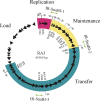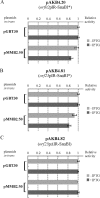Global Transcriptional Regulation of Backbone Genes in Broad-Host-Range Plasmid RA3 from the IncU Group Involves Segregation Protein KorB (ParB Family)
- PMID: 26850301
- PMCID: PMC4959479
- DOI: 10.1128/AEM.03541-15
Global Transcriptional Regulation of Backbone Genes in Broad-Host-Range Plasmid RA3 from the IncU Group Involves Segregation Protein KorB (ParB Family)
Abstract
The KorB protein of the broad-host-range conjugative plasmid RA3 from the IncU group belongs to the ParB family of plasmid and chromosomal segregation proteins. As a partitioning DNA-binding factor, KorB specifically recognizes a 16-bp palindrome which is an essential motif in the centromere-like sequence parSRA3, forms a segrosome, and together with its partner IncC (ParA family) participates in active DNA segregation ensuring stable plasmid maintenance. Here we show that by binding to this palindromic sequence, KorB also acts as a repressor for the adjacent mobC promoter driving expression of the mobC-nicoperon, which is involved in DNA processing during conjugation. Three other promoters, one buried in the conjugative transfer module and two divergent promoters located at the border between the replication and stability regions, are regulated by KorB binding to additional KorB operators (OBs). KorB acts as a repressor at a distance, binding to OBs separated from their cognate promoters by between 46 and 1,317 nucleotides. This repressor activity is facilitated by KorB spreading along DNA, since a polymerization-deficient KorB variant with its dimerization and DNA-binding abilities intact is inactive in transcriptional repression. KorB may act as a global regulator of RA3 plasmid functions in Escherichia coli, since its overexpression in transnegatively interferes with mini-RA3 replication and stable maintenance of RA3.
Copyright © 2016, American Society for Microbiology. All Rights Reserved.
Figures







Similar articles
-
Flexibility in repression and cooperativity by KorB of broad host range IncP-1 plasmid RK2.J Mol Biol. 2005 Jun 3;349(2):302-16. doi: 10.1016/j.jmb.2005.03.062. Epub 2005 Apr 8. J Mol Biol. 2005. PMID: 15890197
-
The centromere site of the segregation cassette of broad-host-range plasmid RA3 is located at the border of the maintenance and conjugative transfer modules.Appl Environ Microbiol. 2011 Apr;77(7):2414-27. doi: 10.1128/AEM.02338-10. Epub 2011 Feb 4. Appl Environ Microbiol. 2011. PMID: 21296952 Free PMC article.
-
Global transcriptional regulator KorC coordinates expression of three backbone modules of the broad-host-range RA3 plasmid from IncU incompatibility group.Plasmid. 2013 Jul;70(1):131-45. doi: 10.1016/j.plasmid.2013.03.007. Epub 2013 Apr 11. Plasmid. 2013. PMID: 23583562
-
Unique Properties of the Alpha-Helical DNA-Binding Protein KfrA Encoded by the IncU Incompatibility Group Plasmid RA3 and Its Host-Dependent Role in Plasmid Maintenance.Appl Environ Microbiol. 2021 Jan 4;87(2):e01771-20. doi: 10.1128/AEM.01771-20. Print 2021 Jan 4. Appl Environ Microbiol. 2021. PMID: 33097508 Free PMC article.
-
Segrosome Complex Formation during DNA Trafficking in Bacterial Cell Division.Front Mol Biosci. 2016 Sep 9;3:51. doi: 10.3389/fmolb.2016.00051. eCollection 2016. Front Mol Biosci. 2016. PMID: 27668216 Free PMC article. Review.
Cited by
-
Transcriptional Organization of the Stability Module of Broad-Host-Range Plasmid RA3, from the IncU Group.Appl Environ Microbiol. 2020 Aug 3;86(16):e00847-20. doi: 10.1128/AEM.00847-20. Print 2020 Aug 3. Appl Environ Microbiol. 2020. PMID: 32532870 Free PMC article.
-
Alpha-Helical Protein KfrC Acts as a Switch between the Lateral and Vertical Modes of Dissemination of Broad-Host-Range RA3 Plasmid from IncU (IncP-6) Incompatibility Group.Int J Mol Sci. 2021 May 5;22(9):4880. doi: 10.3390/ijms22094880. Int J Mol Sci. 2021. PMID: 34063039 Free PMC article.
-
Pseudomonas aeruginosa partitioning protein ParB acts as a nucleoid-associated protein binding to multiple copies of a parS-related motif.Nucleic Acids Res. 2018 May 18;46(9):4592-4606. doi: 10.1093/nar/gky257. Nucleic Acids Res. 2018. PMID: 29648658 Free PMC article.
-
Rules and Exceptions: The Role of Chromosomal ParB in DNA Segregation and Other Cellular Processes.Microorganisms. 2020 Jan 11;8(1):0. doi: 10.3390/microorganisms8010105. Microorganisms. 2020. PMID: 31940850 Free PMC article. Review.
-
Deciphering the Regulatory Circuits of RA3 Replication Module - Mechanisms of the Copy Number Control.Int J Mol Sci. 2022 Sep 1;23(17):9964. doi: 10.3390/ijms23179964. Int J Mol Sci. 2022. PMID: 36077372 Free PMC article.
References
Publication types
MeSH terms
Substances
LinkOut - more resources
Full Text Sources
Other Literature Sources
Research Materials

